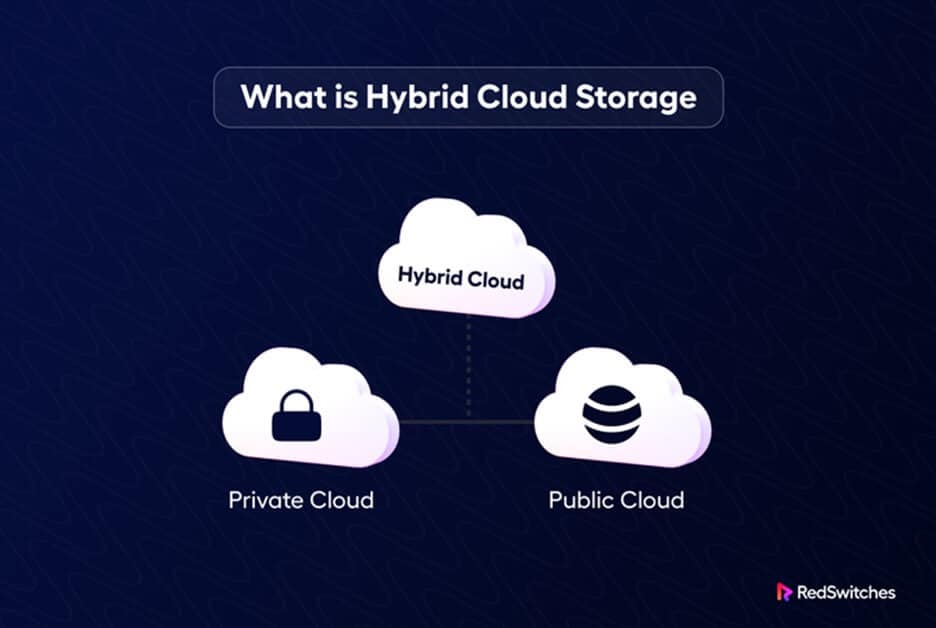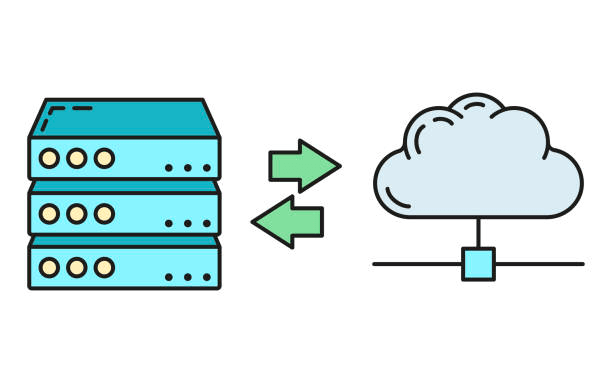Private and public clouds have unique benefits you might want to take advantage of by combining the two. So you might wonder, what is hybrid cloud storage?
Data storage in hybrid clouds is critical to a company’s continuity strategy. It boosts agility, allowing businesses to adapt and change quickly in the face of adversities.
Companies that back up data using hybrid cloud storage ensure that business operations can proceed uninterrupted in the event of a failure or disaster. It empowers businesses to optimize performance, data placement, and cost-efficiency in their infrastructure.
Private cloud storage allows your business more flexibility as you can customize it to meet your needs. However, public cloud storage is cheaper and more scalable.
Now, what happens when you combine both private and public cloud storage? In this article, we find out what hybrid cloud storage is, how it works, and the advantages and disadvantages of setting up the structure.
Table of Content
- What is Hybrid Cloud Storage and How Does it Work?
- What is Hybrid Cloud Storage Architecture?
- Advantages and Disadvantages of Hybrid Cloud Storage
- What Is Hybrid Cloud Object Storage?
- Hybrid Cloud Storage Use Cases
- Hybrid Cloud Storage Examples
- How is Hybrid Cloud Storage Different from other Clouds
- Is Hybrid Cloud Storage the Right Pick for You?
- Key Takeaways
- FAQs
What is Hybrid Cloud Storage and How Does it Work?
Hybrid cloud storage is managing data storage using both cloud and on-premise resources. The architecture combines private, public, and on-premise infrastructures to form an integrated architecture.
The hybrid arrangement allows businesses to enhance data storage capabilities and enjoy both on-premises and cloud computing storage advantages.
Companies typically use hybrid cloud storage to supplement internal data storage with the public cloud. The system shares data across all environments, enabling departments to choose where to store the data and how to handle peaks in IT demand.
Hybrid cloud storage is an infrastructure that acts as a cache to the cloud infrastructure. It handles application backups, system restores, and caches, allowing applications to run faster.
What is Hybrid Cloud Storage Architecture?
A hybrid cloud storage architecture combines public and private cloud storage with on-premises resources. The data infrastructure can share data across all platforms.
Hybrid cloud architectures can vary. One might combine an on-premise infrastructure with a public cloud, a public cloud with a private cloud, or multiple infrastructures simultaneously.
Regardless, all hybrid cloud architectures have three common traits: unified management, network connections, and data integration. Let us elaborate:
- Unified management: Typically, businesses can handle hybrid cloud management using one overarching tool. This eliminates the need to manage each infrastructure separately.
- Network connections: All infrastructures are connected via the public internet or private network. This is crucial for the system to perform uniformly.
- Data integration: The system syncs data on all infrastructures. Businesses may need additional technical solutions to ensure data consistency.
All infrastructures must remain connected. Otherwise, it’s not truly a hybrid cloud, but different cloud infrastructures running parallel with each other.
Advantages and Disadvantages of Hybrid Cloud Storage
Despite its comprehensive advantages, hybrid cloud storage can pause some challenges to businesses without the right strategies. Here are the advantages and disadvantages you should consider:
| Advantages | Disadvantages |
| Cost savings: Hybrid cloud might cost more than public or private cloud storage, but it helps lower long-term costs. You also reduce the cost of migrating two huge data assets between cloud storage platforms. | Complexity: Hybrid cloud storage can be complex to manage, especially for beginners. It has a steeper learning curve because of the different choices and terminology. |
| Scalability: Hybrid cloud makes it easy to scale and meet your organization’s needs easy. Adding more computation power to public clouds and running more complex tasks in the background is easier. | Implementation: Hybrid requires heavy network, storage, and server capabilities, requiring significant capital input. Implementing these may take time to fend off inherent issues that may occur. |
| Flexibility: Companies can leverage public and private cloud advantages using hybrid cloud storage. You can move non-critical data to the public cloud and sensitive data to a private one. | Network bottlenecks: When transferring data between private and public clouds, you use the public internet. This may affect the performance, especially for apps that require fast connections. |
| Security: Hybrid cloud storage has straightforward encryption that ensures your data stays safe on public and private clouds. IT teams have several options to share data. | |
| Control: Businesses can customize the private cloud to suit their needs. It’s also easier to configure the parts of the infrastructure to handle different applications and processes. | |
| Agility: Hybrid cloud storage ensures businesses are agile enough to handle client requests and evolve in adversities. It can connect old systems to new ones and create a structure to meet demands. | |
| Reliability: Hybrid cloud storage reduces potential downtimes, helping your business remain uninterrupted in the case of a failure or disaster. |
What Is Hybrid Cloud Object Storage?
Object storage is an architecture for storing unstructured data. It divides data into objects and stores them in a structurally flat data environment. Each unit or object includes a piece of data, metadata, and a unique identifier for easy access.
Organizations looking to address their growing storage capacity needs and optimize performance should consider hybrid cloud object storage. Key considerations when choosing your cloud object storage solution are flexibility and customization.
Key areas to focus on when choosing the right solution include:
- Deployment models: Can your company customize on-premise, private, and public cloud storage configurations? All deployments should have the same level of reliability and consistency.
- Licensing options: You need different capabilities to meet your organization’s storage requirements. Your vendor should offer a variety of licensing models to give you the flexibility to move data between the enterprise and the cloud.
- Interfaces: A user-friendly interface allows you to deploy data storage hubs supporting file and object workloads. A flexible hybrid cloud storage platform will have an object interface.
Object storage is critical in modern businesses, allowing them to store, access, and leverage large data at scale. Customizing your object storage to meet your needs can improve cost savings, productivity, data acumen, and agility.
Hybrid Cloud Storage Use Cases
Most hybrid cloud storage efforts are wrapped around a few use cases. However, the platform has many benefits to offer. Common use cases include:
Availability and Disaster Recovery
Organizations can implement minor on-premises infrastructures and the cloud. If operations are disrupted on-premises, applications can fail to the cloud and run without noticeable glitches.
Enterprises can also use load balancers to distribute traffic to the cloud and on-premises. This can improve the performance and availability of applications.
Development and Testing
Hybrid cloud storage helps to improve developer productivity since developing applications on the cloud is cheaper and faster. There’s no need to purchase and set up physical hardware.
Hybrid cloud storage allows you to pay as you go, saving you months of setting up equipment. Setting up a development environment is fast, on-demand, and self-serviced.
Migrating workloads
It can take days or weeks to migrate data on-prem to the cloud. However, enterprises with heavy workloads should quickly roll back a change to ensure product availability.
You can leverage hybrid cloud storage to migrate workloads faster and in different phases. Organizations use it to check the optimal services and processes by workload by migrating apps to and from the cloud.
Managing Workloads
Hybrid clouds are useful for dynamic and variable workloads. For example, enterprises can use the cloud to handle support and on-prem for primary workloads.
The cloud could be the backend for collecting and processing patient information from monitoring devices on-prem in the health sector. Think of an order entry system with seasonal spikes in the trade sector.
Hybrid Cloud Storage Examples
In 2009, Salesforce founder and CEO Marc Beinoff, defined cloud computing as a better way to run your business. Today, top brands like Netflix, Hulu, Airbnb, and Uber heavily rely on the hybrid cloud for many reasons.
A few examples of hybrid cloud storage products include:
AWS Outposts
An outpost is a popular hybrid cloud by Amazon Web Services (AWS). It contains similar features to AWS public cloud but is highly scalable, with up to 96 racks to match your computing and storage capacity.
You can use it to offset low-latency tasks to on-prem while still enjoying the speed and services offered by AWS. It’s ideal for companies that want to avoid vendor lock-in.
Azure StorSimple
Azure is a public cloud platform with a hybrid cloud platform called StorSimple. It allows businesses to consolidate storage using physical and virtual infrastructures.
You can use it for data management automation, disaster recovery, compliance, and file security. The company has 3500+ security experts to protect your data and ensure cloud compliance.
IBM Spectrum
IBM offers cloud services like on-prem hardware infrastructures, edge computing, blockchain, and public cloud. IBM Spectrum is a line of products designed for managing complex software-based and storage architectures.
IBM Spectrum Virtualize offers automated tiering to improve system performance, mirror local data in a cloud storage solution, and move data between hybrid cloud components.
How is Hybrid Cloud Storage Different from other Clouds
It’s good to compare different types of clouds to find out which might be best for your company. Public and private clouds are the most common, but people often confuse hybrid clouds and multi-clouds.
Here is a tabular comparison of public, private, and hybrid clouds to help you understand the key differences:
| Aspects | Public Cloud | Private Cloud | Hybrid Cloud |
| Maintenance costs | It has no maintenance costs | It requires some maintenance of on-premises resources | It may require maintenance of on-premises resources |
| Capability | Public clouds are easy to implement but have lower capabilities. | Private cloud offer dedicated and secure storage spaces and are highly customizable | Hybrid clouds allow policy-driven development and optimization apps for speed and availability |
| Cost of Ownership | They have the potential for a high total cost of ownership. | They are expensive and have the potential for a high total cost of ownership. | They have the potential for a high total cost of ownership. |
| Security risks and availability | Public clouds have higher security risks and lower availability. | Private clouds have reduced security risks and higher availability | Hybrid clouds are highly scalable, flexible, and secure. |
| Visibility | You have low visibility and control over the infrastructure | You get exclusive and dedicated environments inaccessible by other organizations | Data storage in a hybrid cloud is based on security, cost, and performance |
Is Hybrid Cloud Storage the Right Pick for You?
Thanks to the growing number of providers, businesses have various cloud options. Hybrid cloud data storage has significant advantages over traditional cloud and on-premises storage.
It’s not enough to have multi-cloud solutions that work parallelly. A hybrid cloud is more flexible in alternating data from on-premises systems to the cloud.
If your business is struggling or plans to migrate big data, hybrid cloud storage can help. It combines the best parts of on-premises, public, and private cloud storage to offer flexibility, cost efficiency, and scalability.
Key Takeaways
- Combining public and private cloud computing can help boost your business agility and ability to adapt in the face of adversity. It empowers businesses to optimize performance, data placement, and cost efficiency.
- Hybrid cloud storage: What is it? It’s managing data on the public or private cloud and on-premises. It empowers businesses to enhance cloud data availability and utilize public and private clouds.
- When choosing hybrid cloud storage, key considerations include monitoring, data encryption, and licensing. Businesses must plan and budget for data egress costs and performance to enhance hybrid cloud storage management.
- Partnering with RedSwitches for hybrid cloud hosting can help your business with infrastructure, expertise, and support to achieve optimal performance, security, and cost savings.
- Thanks to the growing number of providers, you have more options. However, it’s important to consider availability, cost-effectiveness, and performance.
- RedSwitches can help you understand what hybrid cloud storage is good for and how to implement it in your business.
What is hybrid cloud storage? It’s an essential element of any modern business that needs to improve performance, availability of resources, and cost savings. RedSwitches offers hybrid cloud storage solutions for enterprises and startups. Check out our resources and choose a service that fits your business today.
FAQs
Q-1) What is required for a hybrid cloud?
Hybrid clouds combine resources and infrastructures of more than two computing environments. So, they require integration, coordination, and orchestration to synchronize data seamlessly.
Q-2) Why might a company choose to use hybrid cloud storage?
A company might choose data storage in a hybrid cloud to enhance data visibility and control. It improves data security by reducing exposure to critical data. Enterprises using hybrid clouds decide where to house data and workloads based on security management and compliance.
Q-3) Is hybrid cloud cost-efficient?
Using hybrid clouds can save your organization money. Compared to on-premises and stand-alone cloud computing infrastructures, it can seem costly. However, since you combine the pros and cons for each, it’s often a more cost-effective and flexible option.
Q-4) What is an example of hybrid cloud storage?
Hybrid cloud data storage often integrates with industry technologies such as Kubernetes to offer container-based services. It’s also incorporated into Azure Stack, Google Anthos, and AWS services.
Q-5) How does a hybrid cloud work?
Hybrid cloud data storage combines on-prem and cloud data, including public and private clouds. Applications on hybrid clouds run by combining computing, storage, and services of different environments.



